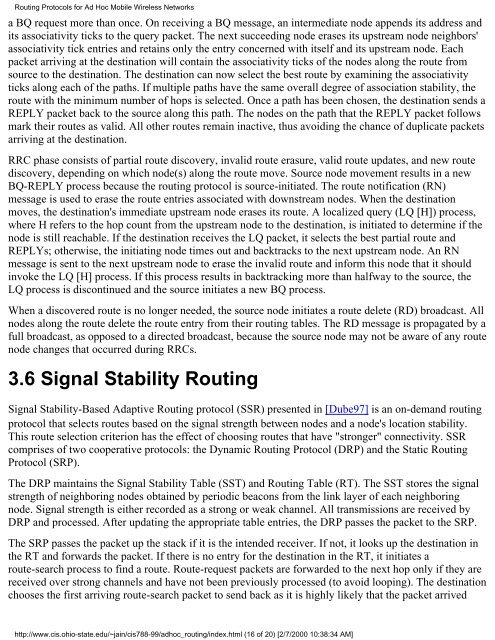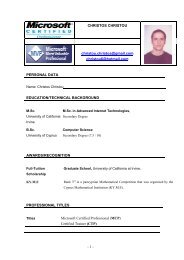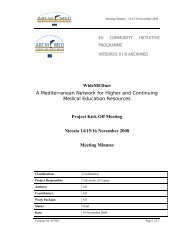Routing Protocols for Ad Hoc Mobile Wireless Networks
Routing Protocols for Ad Hoc Mobile Wireless Networks
Routing Protocols for Ad Hoc Mobile Wireless Networks
Create successful ePaper yourself
Turn your PDF publications into a flip-book with our unique Google optimized e-Paper software.
<strong>Routing</strong> <strong>Protocols</strong> <strong>for</strong> <strong>Ad</strong> <strong>Hoc</strong> <strong>Mobile</strong> <strong>Wireless</strong> <strong>Networks</strong><br />
a BQ request more than once. On receiving a BQ message, an intermediate node appends its address and<br />
its associativity ticks to the query packet. The next succeeding node erases its upstream node neighbors'<br />
associativity tick entries and retains only the entry concerned with itself and its upstream node. Each<br />
packet arriving at the destination will contain the associativity ticks of the nodes along the route from<br />
source to the destination. The destination can now select the best route by examining the associativity<br />
ticks along each of the paths. If multiple paths have the same overall degree of association stability, the<br />
route with the minimum number of hops is selected. Once a path has been chosen, the destination sends a<br />
REPLY packet back to the source along this path. The nodes on the path that the REPLY packet follows<br />
mark their routes as valid. All other routes remain inactive, thus avoiding the chance of duplicate packets<br />
arriving at the destination.<br />
RRC phase consists of partial route discovery, invalid route erasure, valid route updates, and new route<br />
discovery, depending on which node(s) along the route move. Source node movement results in a new<br />
BQ-REPLY process because the routing protocol is source-initiated. The route notification (RN)<br />
message is used to erase the route entries associated with downstream nodes. When the destination<br />
moves, the destination's immediate upstream node erases its route. A localized query (LQ [H]) process,<br />
where H refers to the hop count from the upstream node to the destination, is initiated to determine if the<br />
node is still reachable. If the destination receives the LQ packet, it selects the best partial route and<br />
REPLYs; otherwise, the initiating node times out and backtracks to the next upstream node. An RN<br />
message is sent to the next upstream node to erase the invalid route and in<strong>for</strong>m this node that it should<br />
invoke the LQ [H] process. If this process results in backtracking more than halfway to the source, the<br />
LQ process is discontinued and the source initiates a new BQ process.<br />
When a discovered route is no longer needed, the source node initiates a route delete (RD) broadcast. All<br />
nodes along the route delete the route entry from their routing tables. The RD message is propagated by a<br />
full broadcast, as opposed to a directed broadcast, because the source node may not be aware of any route<br />
node changes that occurred during RRCs.<br />
3.6 Signal Stability <strong>Routing</strong><br />
Signal Stability-Based <strong>Ad</strong>aptive <strong>Routing</strong> protocol (SSR) presented in [Dube97] is an on-demand routing<br />
protocol that selects routes based on the signal strength between nodes and a node's location stability.<br />
This route selection criterion has the effect of choosing routes that have "stronger" connectivity. SSR<br />
comprises of two cooperative protocols: the Dynamic <strong>Routing</strong> Protocol (DRP) and the Static <strong>Routing</strong><br />
Protocol (SRP).<br />
The DRP maintains the Signal Stability Table (SST) and <strong>Routing</strong> Table (RT). The SST stores the signal<br />
strength of neighboring nodes obtained by periodic beacons from the link layer of each neighboring<br />
node. Signal strength is either recorded as a strong or weak channel. All transmissions are received by<br />
DRP and processed. After updating the appropriate table entries, the DRP passes the packet to the SRP.<br />
The SRP passes the packet up the stack if it is the intended receiver. If not, it looks up the destination in<br />
the RT and <strong>for</strong>wards the packet. If there is no entry <strong>for</strong> the destination in the RT, it initiates a<br />
route-search process to find a route. Route-request packets are <strong>for</strong>warded to the next hop only if they are<br />
received over strong channels and have not been previously processed (to avoid looping). The destination<br />
chooses the first arriving route-search packet to send back as it is highly likely that the packet arrived<br />
http://www.cis.ohio-state.edu/~jain/cis788-99/adhoc_routing/index.html (16 of 20) [2/7/2000 10:38:34 AM]




